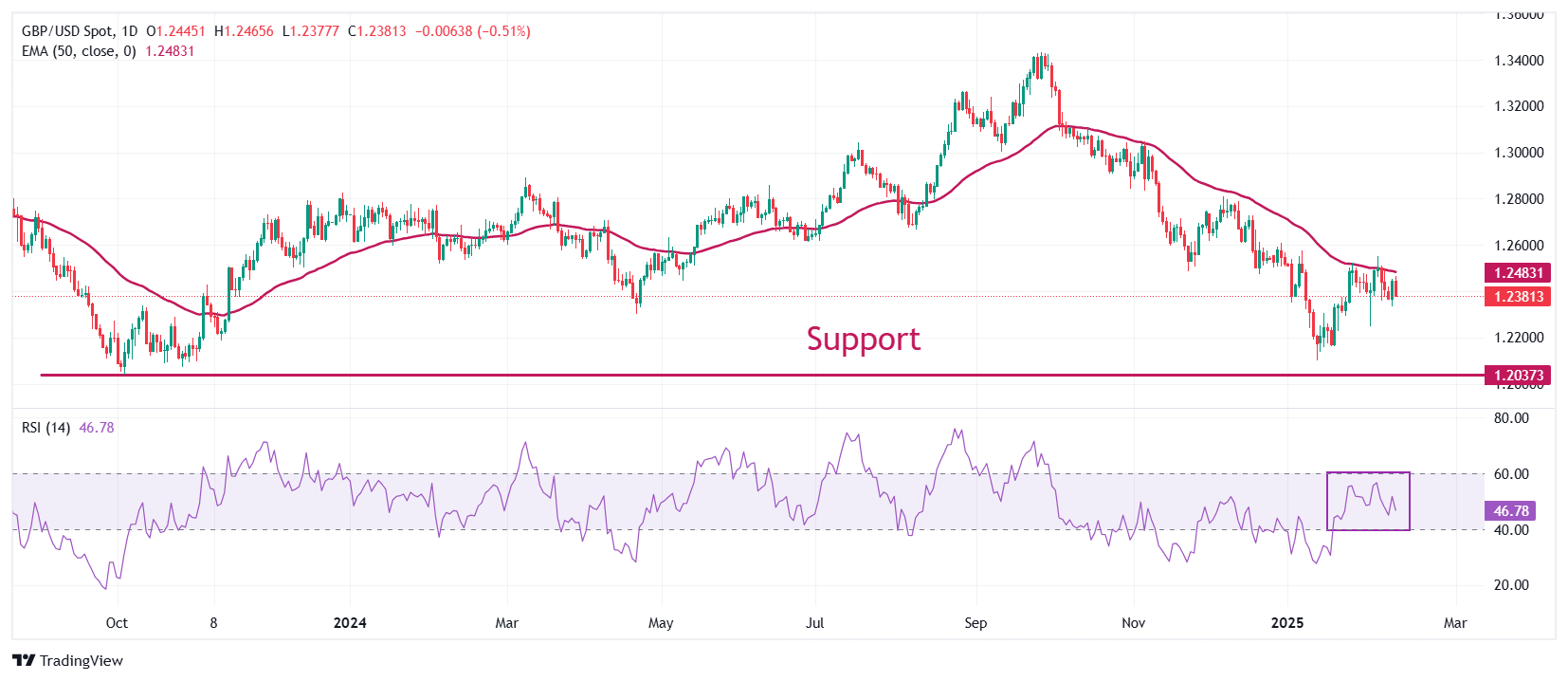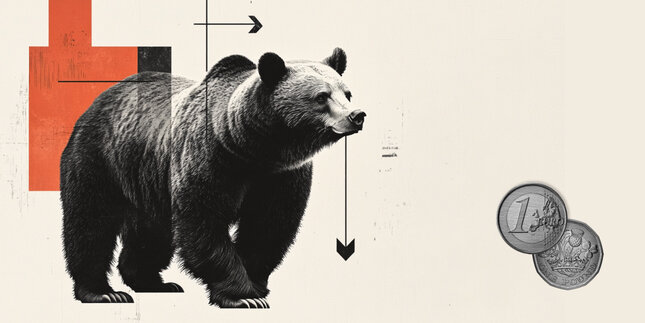Pound Sterling slumps against US Dollar on hot US CPI data
- The Pound Sterling weakens against the US Dollar after the release of the hot US CPI report for January.
- Fed’s Powell stated that the central bank is in no rush to cut interest rates.
- The UK economy is expected to have contracted by 0.1% in the last quarter of 2024.
The Pound Sterling (GBP) tumbles to near 1.2380 from the intraday high of 1.2450 against the US Dollar (USD) in Wednesday’s North American session. The GBP/USD pair falls vertically as the US Dollar strengthens after the release of the hotter-than-expected United States (US) Consumer Price Index (CPI) report for January. the US Dollar Index (DXY), which tracks the Greenback’s value against six major currencies, jumps to near 108.50.
The CPI report showed that the annual core inflation – which excludes volatile food and energy prices – surprisngly rose at a faster pace of 3.3%, compared to a 3.2% increase in December. Economists expected the core CPI to have decelerated to 3.1%. In the same period, the headline inflation grew by 3%, faster than estimates and the former reading of 2.9%. The month-on-month headline and core CPI rose by 0.5% and 0.4%, respectively, while they both were expected to rise by 0.3%.
Stubborn inflation data is likley to boost expectations that the Federal Reserve (Fed) will keep interest rates steady in the range of 4.25%-4.50% for longer.
On Tuesday, Fed Chair Jerome Powell already guided in two-day testimony before the US Congress that the central bank is in “no hurry to cut interest rates”, given resilient economic growth and sticky inflationary pressures. Powell argued that reducing policy restraint “too fast or too much” could “hinder progress on inflation”.
Contrary to the likely impact of hot inflation data, US President Donald Trump said before the CPI data release that interest rates "should be lowered", adding that they would "go hand in hand" with upcoming tariffs.
Daily digest market movers: Pound Sterling is weighed down by growing concerns over UK demand outlook
- The Pound Sterling exhibits a mixed performance against its major peers on Wednesday. However, the outlook of the British economy is uncertain as Bank of England (BoE) Monetary Policy Committee (MPC) member Catherine Mann is worried about the United Kingdom (UK) demand outlook and sees the need to accommodate financial conditions.
- On Tuesday, Catherine Mann said in an interview with the Financial Times (FT) that demand conditions are quite a bit “weaker than has been the case”. Mann favored a bigger interest rate reduction in last week’s policy meeting in which the BoE unanimously decided to cut interest rates by 25 basis points (bps). Investors were surprised by Mann’s vote for a 50 bps interest rate cut as she has been an outspoken hawk. On it, Mann clarified in the interview that she wanted to communicate to traders “what we think are the appropriate financial conditions for the UK economy”.
- Meanwhile, US President Donald Trump’s international agenda will continue to keep investors in risk-sensitive assets on their toes. Donald Trump is poised to announce reciprocal tariffs after signing executive orders imposing a 25% levy on steel and aluminum imports into the US without exemptions or exclusions.
- Going forward, investors will focus on the United Kingdom's Q4 and December month Gross Domestic Product (GDP) data, which will be released on Thursday. The UK economy is expected to have contracted by 0.1% quarter-on-quarter after remaining flat in the third quarter of 2024. On year, the economy is estimated to have expanded by 1.1% compared to the same quarter of 2023, faster than the 0.9% growth in the July-September period.
British Pound PRICE Today
The table below shows the percentage change of the British Pound (GBP) against listed major currencies today. British Pound was the strongest against the Japanese Yen.
| USD | EUR | GBP | JPY | CAD | AUD | NZD | CHF | |
|---|---|---|---|---|---|---|---|---|
| USD | 0.29% | 0.42% | 1.14% | 0.28% | 0.76% | 0.76% | 0.10% | |
| EUR | -0.29% | 0.13% | 0.86% | -0.02% | 0.46% | 0.47% | -0.19% | |
| GBP | -0.42% | -0.13% | 0.69% | -0.14% | 0.33% | 0.34% | -0.33% | |
| JPY | -1.14% | -0.86% | -0.69% | -0.87% | -0.39% | -0.39% | -1.04% | |
| CAD | -0.28% | 0.02% | 0.14% | 0.87% | 0.48% | 0.49% | -0.18% | |
| AUD | -0.76% | -0.46% | -0.33% | 0.39% | -0.48% | 0.00% | -0.66% | |
| NZD | -0.76% | -0.47% | -0.34% | 0.39% | -0.49% | -0.01% | -0.66% | |
| CHF | -0.10% | 0.19% | 0.33% | 1.04% | 0.18% | 0.66% | 0.66% |
The heat map shows percentage changes of major currencies against each other. The base currency is picked from the left column, while the quote currency is picked from the top row. For example, if you pick the British Pound from the left column and move along the horizontal line to the US Dollar, the percentage change displayed in the box will represent GBP (base)/USD (quote).
Technical Analysis: Pound Sterling falls below 1.2400
The Pound Sterling falls back below the key level of 1.2400 against the US Dollar in the North American session on Wednesday after rising to near 1.2450 earlier in the day. The outlook of the GBP/USD pair was already bearish as the 50-day Exponential Moving Average (EMA) around 1.2484 continues to be a major barrier for the Pound Sterling bulls.
The 14-day Relative Strength Index (RSI) oscillates inside the 40.00-60.00 range, suggesting a sideways trend.
Looking down, the January 13 low of 1.2100 and the October 2023 low of 1.2050 will act as key support zones for the pair. On the upside, the December 30 high of 1.2607 will act as key resistance.
Economic Indicator
Consumer Price Index ex Food & Energy (YoY)
Inflationary or deflationary tendencies are measured by periodically summing the prices of a basket of representative goods and services and presenting the data as the Consumer Price Index (CPI). CPI data is compiled on a monthly basis and released by the US Department of Labor Statistics. The YoY reading compares the prices of goods in the reference month to the same month a year earlier. The CPI Ex Food & Energy excludes the so-called more volatile food and energy components to give a more accurate measurement of price pressures. Generally speaking, a high reading is bullish for the US Dollar (USD), while a low reading is seen as bearish.
Read more.Last release: Wed Feb 12, 2025 13:30
Frequency: Monthly
Actual: 3.3%
Consensus: 3.1%
Previous: 3.2%
Source: US Bureau of Labor Statistics
The US Federal Reserve has a dual mandate of maintaining price stability and maximum employment. According to such mandate, inflation should be at around 2% YoY and has become the weakest pillar of the central bank’s directive ever since the world suffered a pandemic, which extends to these days. Price pressures keep rising amid supply-chain issues and bottlenecks, with the Consumer Price Index (CPI) hanging at multi-decade highs. The Fed has already taken measures to tame inflation and is expected to maintain an aggressive stance in the foreseeable future.
Forex News
Keep up with the financial markets, know what's happening and what is affecting the markets with our latest market updates. Analyze market movers, trends and build your trading strategies accordingly.


















